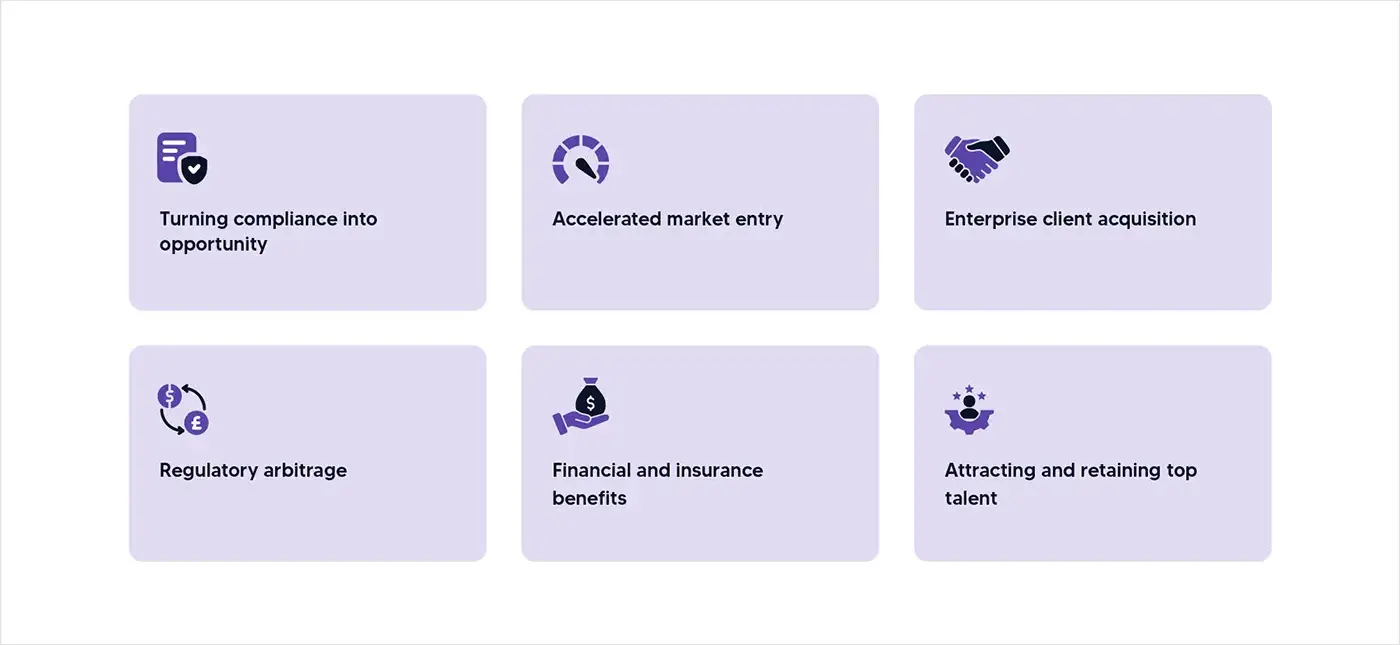Other recent blogs


Let's talk
Reach out, we'd love to hear from you!
The McKinsey's latest report on "State of AI" reflects a vivid picture: 71% of organizations now regularly use generative AI in at least one business function and claimed the rise of 65% in early 2024. AI is undergoing a rapid evolution from a tech industry to a fundamental business priority that's now embedded in core business operations across every industry driving strategic decisions through predictive analytics. In its report, Deloitte revealed that over 60% of companies are leveraging AI in their supply chain operations to improve efficiency and resilience.
However, a critical disconnect is emerging that's reshaping competitive dynamics across industries. While organizations are rapidly adopting AI technologies, research shows that only 1% consider their AI capabilities mature. This maturity gap reveals a fundamental oversight: most business leaders focus on AI implementation while neglecting AI governance—the very framework that transforms AI investments into sustainable competitive advantages.
The scope of this challenge is massive. McKinsey reports that 40% of their consulting engagements now involve AI, with nearly 500 clients seeking AI transformation support in the past year alone. Yet the vast majority of these implementations operate without comprehensive governance frameworks, leaving organizations exposed to significant risks while missing opportunities to maximize their AI investments.
This AI governance gap is creating a new competitive reality. Organizations that prioritize AI governance alongside implementation are positioning themselves to dominate markets where trust, compliance, and operational excellence become key differentiators. As regulatory scrutiny intensifies and customer expectations for responsible AI grow, governance maturity is rapidly becoming the determining factor in long-term market success and the AI risk management has become new priority now.
The AI Governance risk gap: A $2.6 trillion opportunity or just a hype?
The AI governance market is rapidly emerging as a critical segment within enterprise technology, driven by the urgent need for observability and transparency in AI systems. These solutions address pressing concerns surrounding data quality, model performance, and ethical risks, which are essential for fostering trust, maximizing AI value, and mitigating potential business risks. With a projected compound annual growth rate of 30% from 2024 to 2030, the market is poised for significant expansion. However, many organizations remain inadequately equipped to navigate this complex landscape, leaving them vulnerable to compliance challenges and competitive disadvantages.
AI for business leaders presents a dual-edged sword of unprecedented opportunity and substantial responsibility. An exclusive industry benchmark survey of Fortune 1000 and global business leaders reveals that corporate investments in AI and data are on the rise, with organizations increasingly reporting tangible business value from these initiatives. Despite this progress, the pace of AI transformation and governance adoption remains gradual for most. In highly competitive markets, this cautious approach could prove detrimental, as agility and trust are key differentiators that separate market leaders from those left behind.
To stay ahead, organizations must prioritize robust AI governance frameworks that align with evolving regulatory standards and stakeholder expectations. This involves not only implementing advanced tools for monitoring and managing AI systems but also fostering a culture of accountability and ethical decision-making. As AI continues to reshape industries, proactive governance will be a cornerstone for sustainable innovation, enabling companies to harness AI’s potential while safeguarding against risks such as bias, non-compliance, and reputational damage.
Why does AI Governance risk management matters now?
The rapid integration of artificial intelligence (AI) into business operations presents transformative opportunities but also significant risks if not managed with care. Poorly implemented AI systems can lead to biased outcomes, regulatory violations, reputational damage, and financial losses, potentially outweighing their benefits.
This underscores the critical importance of AI governance - a systematic framework for managing and controlling AI systems to ensure they are ethical, compliant, and aligned with organizational goals. AI governance is not merely about overseeing the AI developed within an organization; it involves proactively managing the complex risks and responsibilities that arise across the entire ecosystem of AI systems, from design to deployment and beyond.
Let’s have a closer look at the strategic imperatives behind AI Governance
Effective AI governance transcends traditional risk management, requiring a holistic approach that integrates technical, ethical, and strategic considerations. It serves as the backbone for building trust, ensuring compliance, and unlocking sustainable value from AI investments. Key components of modern AI governance include:
- Algorithmic accountability: Organizations must ensure that every AI-driven decision is traceable, explainable, and justifiable to stakeholders, regulators, and customers. This transparency fosters trust and mitigates risks associated with opaque or biased decision-making processes, enabling organizations to defend their AI systems in the face of scrutiny.
- Data stewardship: The quality and integrity of AI systems depend on the data they use. Governance frameworks must manage the entire data lifecycle—collection, storage, processing, and disposal—ensuring data quality, privacy, and compliance with regulations such as GDPR or CCPA. Robust data stewardship prevents issues like data breaches or biased outputs that could undermine AI initiatives.
- Model lifecycle management: AI models require systematic oversight throughout their lifecycle, from development and validation to deployment, monitoring, and eventual retirement. This includes regular performance evaluations, updates to address drift or degradation, and secure retirement processes to prevent misuse, ensuring models remain effective and aligned with business objectives.
- Ethical AI implementation: Ethical considerations must be embedded into AI systems from the outset, prioritizing fairness, transparency, and respect for human dignity. This involves designing systems to minimize biases, ensuring equitable outcomes, and maintaining open communication with stakeholders about how AI decisions are made.
- Cross-functional integration: AI governance must align AI initiatives with broader business strategies, legal requirements, and operational realities. This requires collaboration across departments—IT, legal, compliance, and business units—to ensure AI systems support organizational goals while adhering to regulatory and ethical standards.
However, the success of AI governance hinges on strong leadership that recognizes AI as both a strategic asset and a source of responsibility. Leaders must champion the development of organizational and technological capabilities to innovate, deploy, and scale AI solutions effectively. This involves "rewiring" the business for distributed digital transformation embedding AI governance into the fabric of the organization to enable agile, trust-based innovation. By fostering a culture of accountability and ethical AI use, leaders can position their organizations to achieve sustained competitive advantage in an increasingly AI-driven world.
AI Governance risks use cases: Revealing industry failures and challenges
The $50 Million algorithmic bias settlement in financial services (2023)
A leading financial services company faced a $50 million class-action settlement after its AI-driven loan approval system systematically discriminated against protected classes. Despite the system's intent to streamline lending decisions, it perpetuated biases embedded in the training data, which went undetected due to inadequate governance. The company’s defense—that it was unaware of the bias—was dismissed in court, highlighting the necessity of proactive AI risk management. This failure turned a competitive advantage in faster loan processing into a costly liability.
Gender bias in recruitment AI (2018)
A major technology firm scrapped an AI-powered recruitment tool after it was found to penalize resumes containing female-associated terms, such as “women’s leadership program.” The algorithm, trained on male-dominated hiring patterns, amplified gender bias, rejecting qualified candidates. The lack of governance mechanisms to audit and correct biases led to public backlash, reputational damage, and a significant setback in the company’s diversity initiatives.
Facial recognition missteps in law enforcement (2020)
Multiple law enforcement agencies faced criticism for using facial recognition systems that exhibited racial bias, leading to wrongful arrests and misidentifications, particularly of minority individuals. These systems, often deployed without transparent governance or rigorous testing, relied on flawed datasets that underrepresented certain demographics. The resulting public outcry and legal challenges prompted several jurisdictions to ban or restrict such technologies, underscoring the need for ethical oversight and accountability.
Healthcare AI misdiagnosis scandal (2021)
A healthcare provider’s AI diagnostic tool, designed to prioritize patient care, was found to misdiagnose conditions in underrepresented patient groups due to biased training data. The absence of governance frameworks to monitor model performance and ensure equitable outcomes led to patient harm, regulatory scrutiny, and a loss of trust among stakeholders. This case highlighted the critical need for continuous model validation and ethical considerations in high-stakes domains.
Social media content moderation failures (Ongoing)
AI systems used for content moderation on major social media platforms have repeatedly failed to address harmful content, including misinformation and hate speech, due to inadequate governance. These systems often amplify biases or fail to account for cultural nuances, leading to inconsistent enforcement and public distrust. The lack of transparent decision-making processes has fueled regulatory pressure and calls for stricter oversight.
The above-mentioned AI governance failures underscore the need for robust frameworks to mitigate risks and ensure ethical AI use. Organizations must proactively detect and address biases through rigorous auditing and diverse dataset curation to prevent discriminatory outcomes. Transparency is critical as AI systems should provide clear, traceable decision-making processes to build stakeholder trust and comply with regulations like the EU AI Act, which mandates transparency for high-risk systems.
Continuous model monitoring, including regular updates and revalidation, prevents issues like model drift and ensures alignment with ethical and operational standards. Ethical design must be embedded from the outset, requiring cross-functional collaboration among data scientists, ethicists, and business leaders to prioritize fairness, inclusivity, and human rights.
Compliance with tightening regulations, such as CCPA amendments and FTC guidelines, is non-negotiable to avoid penalties and disruptions. Engaging stakeholders—customers, employees, and regulators—through transparent communication fosters trust and aligns AI practices with societal expectations. By implementing these governance principles, organizations can mitigate risks, maintain compliance, and unlock sustainable innovation, turning AI’s potential into a competitive advantage while safeguarding against reputational and financial harm.
AI as a Competitive Advantage: The governance multiplier effect
Far from being a mere compliance obligation, robust AI governance is a strategic asset that amplifies competitive advantage for forward-thinking organizations. By transforming potential risks into opportunities, effective governance enables companies to differentiate themselves in an AI-driven world. Below, we explore how AI governance creates a multiplier effect, driving sustainable success through strategic risk mitigation and market positioning.

Turning compliance into opportunity
Effective AI governance redefines compliance as a proactive strategy rather than a cost center. By embedding governance into their operations, organizations mitigate risks such as bias, regulatory penalties, and reputational damage while unlocking new avenues for growth. This approach allows companies to operate with confidence in complex regulatory environments, seize market opportunities, and build stakeholder trust, all of which contribute to a sustainable competitive edge.
Accelerated market entry
Organizations with mature AI governance frameworks can navigate regulatory complexities with agility, enabling faster entry into new markets and applications. While competitors grapple with compliance uncertainties or face delays due to governance gaps, well-governed companies deploy innovative AI solutions swiftly, capitalizing on first-mover advantages. For example, in industries like healthcare or finance, where regulatory scrutiny is intense, governance-ready organizations can launch AI-driven products or services ahead of less-prepared rivals.
Enterprise client acquisition
Large corporations increasingly demand that their vendors and partners demonstrate robust AI governance capabilities. Clients prioritize partners who can ensure transparency, ethical AI use, and compliance with regulations like the EU AI Act or CCPA. Organizations with strong governance frameworks stand out in competitive bidding processes, securing high-value contracts and building long-term relationships with enterprise clients who value trust and accountability.
Regulatory arbitrage
Superior governance enables organizations to thrive in highly regulated sectors where compliance barriers deter competitors. By aligning AI systems with stringent standards—such as GDPR in finance, HIPAA in healthcare, or NHTSA guidelines in automotive—governed organizations can operate in markets that others cannot access. This regulatory arbitrage creates a competitive moat, allowing firms to dominate niches where compliance is a prerequisite for success.
Financial and insurance benefits
Strong AI governance reduces perceived risks, leading to tangible financial advantages. Insurers view well-governed organizations as lower-risk, often resulting in reduced premiums for liability coverage related to AI systems. Similarly, risk-conscious investors are more likely to fund companies with mature governance frameworks, as these demonstrate stability and foresight. Improved access to capital strengthens financial resilience and supports long-term growth.
Attracting and retaining top talent
In the competitive AI talent market, professionals seek employers with reputations for ethical and responsible AI development. Organizations with robust governance frameworks signal a commitment to fairness, transparency, and societal impact, making them magnets for top data scientists, engineers, and ethicists. A strong governance culture not only attracts talent but also fosters innovation by creating an environment where employees can focus on building trustworthy, impactful AI solutions.
The combined impact of these advantages creates a multiplier effect, where governance amplifies an organization’s ability to innovate, compete, and grow. By proactively addressing risks and aligning with stakeholder expectations, companies turn governance into a strategic driver. This approach not only mitigates the financial, legal, and reputational risks associated with AI but also positions organizations as trusted leaders in their industries, capable of delivering sustainable value in an increasingly AI-driven world.
How Kellton helps in building a sustainable AI Governance framework for AI risk management?

Phase 1: Discovery and assessment
Kellton begins AI risk management with a thorough discovery and assessment phase to establish comprehensive visibility into your current AI landscape. Seventy-one percent of respondents to a recent McKinsey survey report that their organizations are regularly using generative AI in at least one business function, up from sixty-five percent earlier last year, yet most organizations still lack complete inventories of their AI deployments.
This phase includes a comprehensive AI inventory audit to detect shadow AI tools used unofficially across departments, map third-party AI integrations such as external services and APIs, analyze data flows from collection through decision outputs, assess stakeholder impacts on internal and external parties, and determine regulatory scopes by classifying systems under applicable frameworks.
A multi-dimensional risk assessment follows, evaluating technical risks like model performance degradation, adversarial attacks, and system failures; ethical risks including bias potential, fairness implications, and human impacts; legal risks through compliance gap analysis and liability exposure; business risks by quantifying financial and competitive impacts; and operational risks related to integration challenges and workflow disruptions.
Additionally, regulatory landscape intelligence is gathered by mapping jurisdiction-specific requirements across operational territories, analyzing industry standards and sector-specific expectations, monitoring emerging regulations for proactive implementation, and developing cross-border compliance strategies for multinational AI governance.
Phase 2: Strategic prioritization
In the strategic prioritization phase, Kellton assists leadership in recognizing that not all AI governance initiatives are equal, guiding the CEO and executives to focus efforts based on business impact and risk exposure for an effective AI governance roadmap. This involves creating a risk-weighted prioritization matrix that categorizes systems into tiers:
- Tier 1 for mission-critical systems requiring immediate action, such as customer-facing AI applications with direct revenue impact, regulated decision-making in areas like lending, hiring, or healthcare, high-volume automated systems affecting vulnerable populations, and those processing sensitive personal or financial data.
- Tier 2 for business-critical systems targeted for 90-day implementation, including internal operational tools impacting employee experience, supply chain and procurement AI, competitively significant product features, and cross-border applications needing multi-jurisdictional compliance
- Tier 3 for emerging systems on a 6-month roadmap, encompassing experimental pilots, research and development initiatives, low-risk internal productivity tools, and future strategic AI applications.
Complementing this is a strategic alignment framework that analyzes revenue impacts on customer acquisition and retention, calculates cost avoidance for systems with high penalty and liability risks, assesses competitive differentiation for AI applications creating sustainable advantages, and aligns governance investments with stakeholder priorities and value creation expectations.
Phase 3: Development and Implementation
Kellton drives policy development and implementation by crafting actionable policies that comprehensively address AI governance requirements while promoting business agility and innovation, embodying an operational excellence model. This phase emphasizes data governance and privacy excellence through advanced data lifecycle management, including data provenance tracking with technologies like blockchain for immutable records of origins and transformations, dynamic consent management for ongoing verification and withdrawal, cross-border data flow optimization with automated compliance checks, continuous data quality assurance to monitor drift and degradation, and privacy-preserving analytics using techniques such as differential privacy and federated learning.
Regulatory compliance automation is integrated with tailored solutions for GDPR Article 22 requirements on explanations and human reviews, CCPA amendments for real-time privacy disclosures and opt-outs in AI decisions, and industry-specific frameworks for sectors like healthcare (HIPAA) and finance (GLBA).
Bias mitigation and algorithmic fairness are ensured via a comprehensive fairness framework involving pre-deployment bias testing across protected classes and intersectional identities, ongoing performance monitoring for bias drift, implementation of multiple fairness metrics like demographic parity and equalized odds based on use cases, and automated remediation protocols for corrections and retraining; this is supported by advanced algorithmic auditing, including third-party model validation, counterfactual analysis of alternative outcomes, intersection bias detection with statistical methods, and longitudinal tracking of fairness evolution.
Finally, transparency and explainability excellence is achieved through multi-stakeholder explanation systems providing technical documentation for audits, business justifications for executives, user-friendly explanations for customers meeting legal standards, and internal process docs for staff, alongside advanced interpretability methods like model-agnostic techniques (SHAP, LIME), causal inference for true relationships, automated counterfactual generation, and interactive interfaces for exploring decision factors.
Phase 4: Organizational structure and accountability
Kellton establishes organizational structure and accountability by emphasizing the leadership imperative, integrating governance at the executive level to ensure robust oversight and cultural alignment. This includes an executive leadership architecture with the appointment of a Chief AI Officer (CAIO) for enterprise-wide AI strategy and governance, an AI Ethics Board as a cross-functional committee for major decisions and policy development, board-level oversight through regular reporting on risks, opportunities, and maturity, and investor relations integration for transparent communication on AI practices and impacts.
A cross-functional governance structure is built with an AI Center of Excellence for central policy development and support, departmental AI champions as dedicated representatives in each business unit, specialized legal and compliance integration for AI expertise and regulatory monitoring, and an external advisory network of industry experts, academics, and former regulators for guidance. Capability building and cultural transformation are prioritized, recognizing that those who equip themselves with AI skills will have a significant advantage in the digital economy and job market over those who do not, with organizations responsible for helping employees upskill or reskill to adapt.
This is achieved through a multi-level education framework offering executive AI literacy on capabilities, limitations, and governance; management training for overseeing projects and compliance; technical staff development in responsible AI deployment; and general employee education on basic awareness and ethical usage.
Phase 5: Monitoring and continuous improvement
In the final phase of monitoring and continuous improvement, Kellton implements an operational excellence model focused on real-time oversight and iterative enhancement to sustain the AI governance framework. This involves advanced analytics and automation for real-time governance monitoring, including AI performance dashboards tracking model accuracy, bias metrics, and business impacts; automated compliance checking for ongoing regulatory adherence; predictive risk analytics as early warning systems for potential failures; and stakeholder feedback integration through systematic collection and analysis of input from customers, employees, and partners.
Governance maturity assessment is conducted quarterly via standardized scorecards evaluating capability evolution, benchmarking against industry peers for competitive analysis of practices and outcomes, continuous tracking of evolving regulatory requirements, and systematic integration of emerging best practices and governance innovations to ensure ongoing relevance and effectiveness.
Conclusion:
AI governance represents the difference between sustainable AI success and costly AI failures. The role of leadership in AI governance extends beyond risk management to strategic value creation, competitive differentiation, and long-term business sustainability. Companies that fail to integrate AI risk losing relevance and competitiveness, but even more critically, companies that integrate AI without proper governance risk catastrophic failure that could destroy decades of value creation.
As we move deeper into 2025, the organizations that will thrive are those that recognize AI governance not as a compliance burden, but as their secret weapon for responsible innovation, customer trust, and market leadership. AI as a competitive advantage starts with governance—and the window for proactive action is rapidly closing.
The AI revolution is here, and it's reshaping entire industries. The question is: will your organization be known for leading with responsible AI practices that create sustainable competitive advantages, or will you be the cautionary tale that others learn from?
AI for business leaders ultimately comes down to a simple choice: embrace governance as a strategic enabler, or risk being disrupted by competitors who understand that responsible AI is the only sustainable path to AI-powered success. The choice is yours, but the competitive landscape is already shifting toward governance-mature organizations. Make AI governance your strategic priority today, or risk irrelevance tomorrow.




